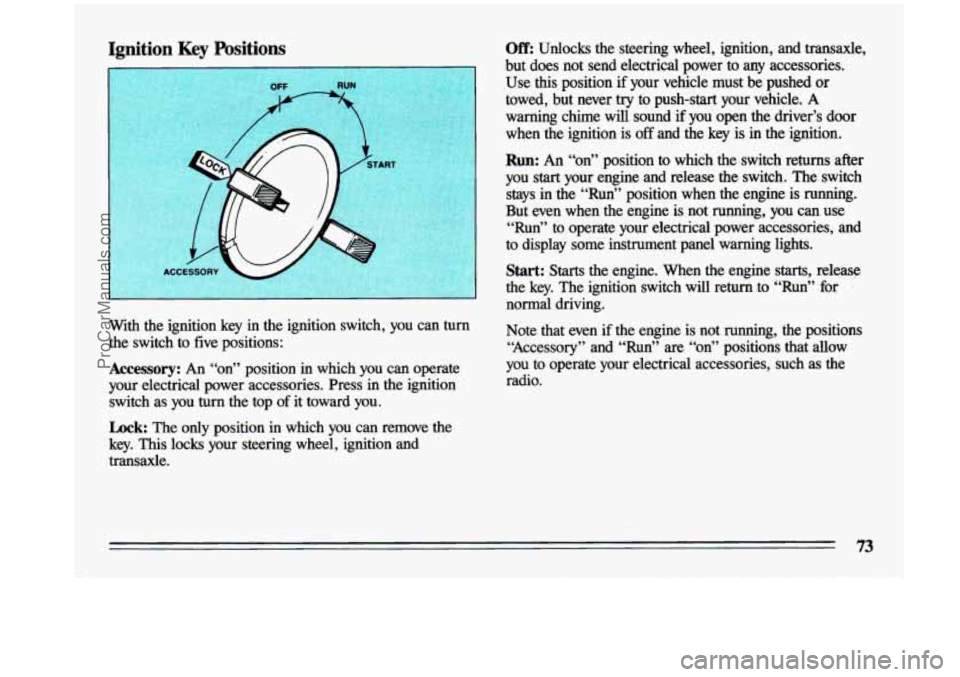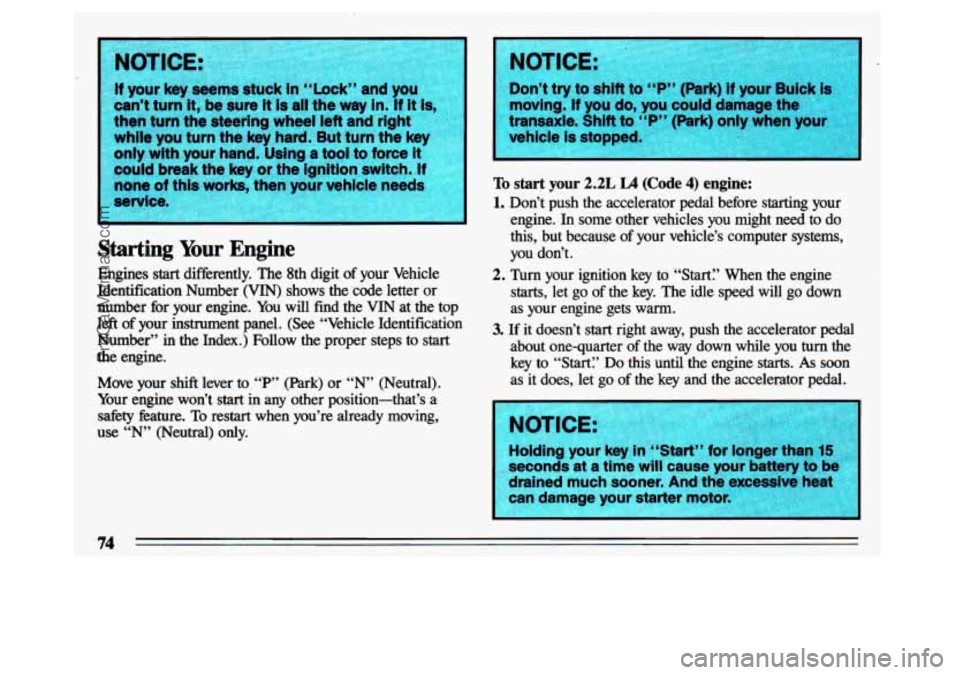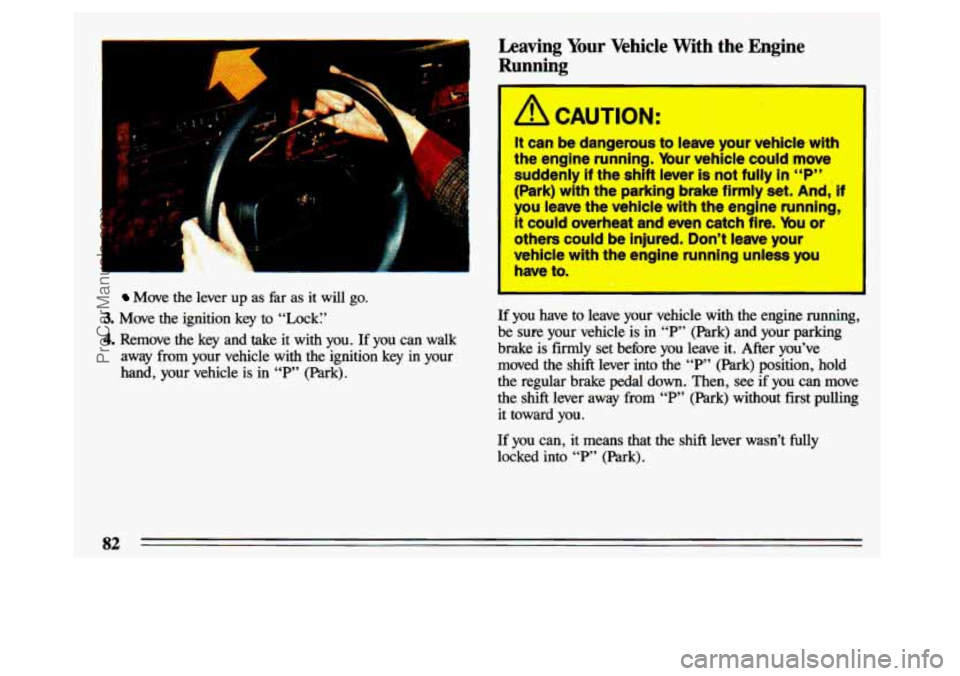Page 74 of 324
Parking at Night: Park in a lighted spot, close all
windows and lock your vehicle. Remember
to keep your
valuables out of sight. Put them
in a storage area, or take
them with you.
Parking Lots: If you park in a lot where someone will be
watching your vehicle, it’s best
to lock it up and take your
keys. But what if you have to leave your ignition key?
What if you have to leave something valuable in your vehicle?
1. Put your valuables in a storage area, like your trunk or
glove box, or rear storage area in the’ wagon.
2. Lock the glove box.
3. Lock all the doors except the driver’s.
4. Then take the door key with you.
New Vehicle “Break-In”
72
ProCarManuals.com
Page 75 of 324

Ignition Key Positions Off: Unlocks the steering wheel, ignition, and transaxle,
but does not send electrical power to any accessories.
.Use
this position if your vehicle must be pushed or
towed, but never try to push-start your vehicle.
A
warning chime will sound if you open the driver’s door
when the ignition
is off and the key is in the ignition.
I
Run: An “on” position to which the. switch returns after
you
start your engine and release the switch. The switch
stays in the “Run” position when the engine is running.
But even when the engine is not running, you can use
“Run” to operate your electrical power accessories, and
to display some instrument panel warning lights.
Start: Starts the engine. When the engine starts, release
the key. The ignition switch will return to “Run” for
normal driving.
with the ignition key
h the ignition switch, YOU can turn Note that even if the engine is not running, the positions
the switch to five positions: “Accessory” and “Run” \
are “on” positions that allow
.Accessory: An “on” position in which you can operate you to operate your electrical accessories, such as the
your electrical power accessories. Press
in the ignition ‘ radio.
switch as you
turn the top of it toward you.
Lock: The only position in which you can remove the
key. This locks your steering wheel, ignition
and
transaxle.
ProCarManuals.com
Page 76 of 324

I I.
If your key &ems suwn in ‘‘Lu~n IU Y~U
can’t turn it, be sure it is all the way in. If it is,
then turn the steering wheel left and right
while you turn the key hard. But turn the key
only with your hand. Using
a tool to force it
could break the key or the ignition switch. If
none
of this works, then your vehicle needs
service.
I
Starting Your Engine
Engines start differently. The 8th digit of your Vehicle
Identification Number (VIN) shows the code letter or
number for your engine. You will find the VIN at the top
left of your instrument panel. (See “Vehicle Identification
Number” in the Index.) Follow the proper steps to
start
the engine.
Move your shift lever to
“P” (Park) or “N” (Neutral).
Your engine won’t
start in any other position-that’s a
safety feature.
To restart when you’re already moving,
use “N” (Neutral) only.
To start your 2.2L L4 (Code 4) engine:
1. Don’t push the accelerator pedal before starting your
engine. In some other vehicles you might need to do
this, but because
of your vehicle’s computer systems,
you don’t.
starts, let go of the key. The idle speed will go down
as your engine gets warm.
3. If it doesn’t start right away, push the accelerator pedal
about one-quarter of the way down while you turn the
key
to “Start;’ Do this until the engine starts. As soon
as it does, let go of the key and the accelerator pedal.
2. Turn your ignition key to “Start:’ When the engine
74
ProCarManuals.com
Page 77 of 324

4. If your engine still won’t start (or starts but then
stops), it could be flooded with too much gasoline.
Try pushing your accelerator pedal all the way to the
floor and holding it there as you hold the key in
“Start” for about three seconds. If the car starts
briefly but then stops again, do the same thing, but
this time keep the pedal down for five or six seconds.
This clears the extra gasoline from the engine.
To start your 3300 V6 (Code N) engine:
1. Don’t push the accelerator pedal before starting your
engine. In some other vehicles you might need to do
this, but because of yourwehicle’s computer systems,
you don’t.
starts, let go of the key. The idle
speed will go down
as your engine gets warm.
2. Turn your ignition key to “Start? When the engine
3. If it doesn’t start right away, push the accelerator pedal
about one-quarter of the way down while you turn the
key to “Start;’ Do
this until the engine starts. As soon
as it does, let go of the key and the accelerator pedal.
seconds-at a time will cause your battery to b
drained much sooner. And the excessive hea
can damage your starter motor,
4. If your engine still won’t start (or starts but then
stops), it could be flooded with too much gasoline.
Try pushing your accelerator pedal all the way to the
floor and holding it there as you hold the key in
“Start” for about
15 seconds. This clears the extra
gasoline from the engine. Turn the ignition
key to
“Off’ Wait 10 seconds, then repeat Step 3.
I
I
75
ProCarManuals.com
Page 82 of 324
Parking Brake
The parking brake uses the brakes on the rear wheels.
I
To set the parking brake:
Hold the regular brake
pedal down with your right
foot. Push down the
parking brake pedal with
your left foot.
If the ignition
is on, the brake system
I warning light will come on.
L
I
To release the parking
brake:
Hold the regular
brake pedal down. Pull the
brake release lever.
NOTICE:
Driving with thiparl ‘g brake or )use
your rear brakesto oveFheat. ybu may have
-
replace them, and you could alse damage
other parts
of your vehicle.
If you are on a hill: See “Parking on Hills” in the Index.
That section shows
how to turn your front wheels.
If you are towing a trailer and are parking on any
hill: See “Towing a Trailer” in the Index. That section
shows what to do first to keep the trailer from
moving.
80
ProCarManuals.com
Page 84 of 324

F- LA- 1
Move the lever up as far as it will go.
3. Move the ignition key to “Lock:’
4. Remove the key and take it with you. If you can walk
away from your vehicle with the ignition key in your
hand, your vehicle is
in “P” (Park).
Leaving Your Vehicle With the Engine
Running
It can be dangerous to leave your vehicle with
the engine running. Your vehicle could move
suddenly if the shift lever is not fully in
“P”
(Park) with the parking brake firmly set. And, if
you leave the vehicle with the engine running,
it could overheat and even catch fire. Ybu or
others could be injured. Don’t leave your
vehicle with the engine running unless you
have to.
If you have to leave your vehicle with the engine running,
be sure your vehicle
is in “P” (Park) and your parking
brake is firmly set before you leave it. After you’ve
moved the shift lever into
the “P” (Park) position, hold
the regular brake pedal down. Then, see if you can move
the shift lever away from
“P” (Park) without first pulling
it toward you.
If you can, it means that the shift lever wasn’t hlly
locked into
“P’ (Park).
82
ProCarManuals.com
Page 87 of 324
Power Windows (Option)
*.”
._
Flip-Open Rear Vent Windows (Option, Wagon)
With power windows, switches on the driver’s armrest
control each
of the windows when the ignition is on. In
addition, each passenger door has a control switch for its
own window. To open, pull the latch forward, then push on the center
of the latch to swing the window out into the open
position.
To close the window, pull the center of the latch and then
press the latch into the closed position.
85
ProCarManuals.com
Page 96 of 324

Passing Another Vehicle While Using Cruise Control
Use the accelerator pedal to increase your speed. When
you take your foot
off the pedal, your vehicle will slow
down
to the Cruise Control speed you set earlier.
Using Cruise Control on Hills
How well your Cruise Control will work on hills
depends upon your speed, load, and the steepness
of the
hills. When going up steep hills, you may have
to step on
the accelerator
pedal to maintain your speed. When going
downhill, you may have to brake or shift
to a lower gear
to keep your speed down.
Of course, applying the brake
takes you out
of Cruise Control. Many drivers fmd this to
be too much trouble and don’t use Cruise Control on
steep hills.
To Get Out of Cruise Control
L
-.
There are two ways to turn
off the Cruise Control:
Step lightly on the brake
pedal;
OR
Move the Cruise switch
to
“OFF?
To Erase Cruise Speed Memory
When you turn off the Cruise Control or the ignition,
your Cruise Control set speed memory is erased.
94
ProCarManuals.com